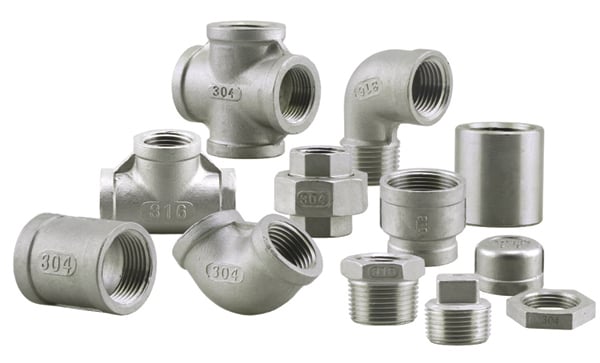The Benefits of Stainless Steel Fittings
Stainless steel is a versatile material that is used in many different applications. The two most common types of stainless steel are austenitic which is highly corrosion resistant and ferritic which is magnetic.
In this blog we are going to break down the basics of what austenitic stainless steel is, the key benefits it provides and where the uses of stainless steel fittings can be most beneficial.
Stainless Steel
All steels have the same basic iron and carbon composition along with nickel, but stainless steel also contains chromium - the alloy that gives stainless steel its well-known corrosion resistance.
Austenitic stainless steel contains high levels of chromium and nickel and low levels of carbon providing a balance of strength, workability and corrosion resistance. The standard stainless steel alloys used in plumbing applications contains between 18-20% chromium and 8-12% nickel, as well as small amounts of carbon 0.08% and manganese 2%. Austenitic stainless steel has the highest corrosion resistance and are the most commonly used type of stainless steel around the world.
Benefits of Stainless Steel Fittings
Stainless steel offers a wide range of benefits to the architect and designer of plumbing systems:
Material Benefits
The combining of corrosion resistance with high strength allows the reduction in wall thickness and weight. Stainless steel is resistant to heat and chemical damage. It can withstand very high flow rates - in excess of 40m/s, making it capable to withstand long-term exposure to the elements in almost any environment.
Environmental Benefits
Stainless steel can be used in all types of water, including drinking water in public supply. It has an excellent resistance to the full range of potable waters, including various chloride levels. At the end of its useful life, stainless steel is fully recyclable and retains a higher residual scrap value than ordinary steel.
Economic Benefits
Stainless steel is low maintenance and requires no additional coating, in both indoor and outdoor applications. The expected lifetime of a stainless steel system is more than 50 years, reducing system down time, replacement and maintenance costs over the life of the installation.
Stainless Steel Fitting Applications
With all the benefits that come with stainless steel there are equally just as many applications where these fittings can be utilized. Here are some key beneficial areas:
- Residential & Commercial water systems that are subject to various stresses.
- Commercial & Industrial piping systems that are needing to perform well under the toughest and harshest conditions.
- Industrial Projects for sanitary or highly corrosive applications.

There are a variety of stainless steel fittings on the market, the most common ones are bushings, caps, couplings, crosses, elbows, locknut, plugs, tees, unions and valves. The most commonly used grades are 304 and 316, both are available in a heavy and light pattern option and with a vast size range.
No matter the plumbing situation, there is a stainless steel fitting for the job.
Until stainless steel came and took it to another level, brass pipe fittings were primarily used in the industrial and commercial sectors. The improvement in material preferences came quickly after seeing the impressive advantages of stainless steel for other uses!
Today, not only pipe fittings but also flanges and instrumentation valves are made of stainless steel.
What Are Pipe Fittings?
A pipe fitting is generally used to connect bores of two (or multiple) pipes or tubes to separate equipment. Manufacturers of stainless steel pipe fittings in India also suggest further use for pipe fittings, i.e. as a fluid flow control device. You can also use pipe fittings to close and seal any pipe.
Pipe Fittings Can Be Bought In Two Forms
Pipe Fittings are available in two forms, i.e. Male fittings and Female fittings. What is the difference?
Female threads are used on the inside of threaded pipe fittings while male threads are fitted out on the pipe fittings. Pipe fittings typically have one female end with the other being male. These are known as street fittings. You can use pipe fittings to connect pipes and tubes in the following ways:
- By Threading
Threaded (metal) pipes are threaded together in this process to connect to the standard fittings and pipes.
- By Slip-fit
These pipes are designed with sleeves that help easily slip one pipe into another tube fitting.
Why Stainless Steel Pipe Fittings
Stainless steel is a type of steel that demonstrates high corrosion resistance. The steel is self-repairing due to the formation of a passive oxide film. This protective layer’s resistance properties improve with an increase in chromium content and molybdenum levels. Generally, the typical stainless steel alloys for piping contain 17-18 percent chromium content and 8-12 percent nickel content. Stainless Steel 304 Pipe Fittings and SS 316 Pipe Fittings are the most commonly used pipe fittings.
Tips To Make Pipe Fittings Selection Easier
There are different types of pipe fittings available which can make it difficult for buyers to choose the most suitable one according to the application it is needed for. Below are some helpful points that will make the selection process easier.
Connection Type: Every fitting has two different connector types, i.e. one end could be male threaded and the other female threaded. Similarly, one end could be threaded while the other could feature a male slip.
Materials Used In Construction: Experts don’t have a set rule here. But those pipe fittings are better that are of the same material as the pipe where fittings will be applied. There are some cases where this rule isn’t applied.
Other important considerations are:
- Fitting type
- Size
- Check for flow
- Design
- Standards and codes
- Thickness
Finding the appropriate pipe fitting, instrumentation valve and tube fitting for your application has become easier with the help of an extensive product catalog.
.jpg?width=1200&name=BenifitsSSF(FI).jpg)


评论
发表评论